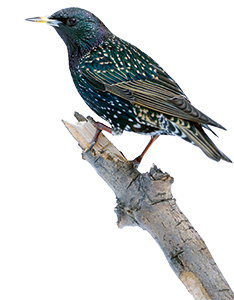Fiction: All blackbirds are starlings.
Fact: As with most common names, several species are referred to as blackbirds. Starlings (Sturnus vulgaris), however, get their name from the word star. When they undergo their annual molt after breeding, they have white tips on their feathers that give them a speckled appearance. By spring, the tips are worn off, and they sport a sleek, black appearance. Their bills also change from black in the fall to yellow in the spring.

- Did you know? Starlings account for more than $800 million in agriculture losses a year. Photo: ©istock.com/Andrew_Howe
Fiction: Starlings have beaks typical of seed eaters.
Fact: Starlings have an unusual beak that’s spring-loaded. It springs open to pry apart seeds and plants (winter) or to grip insect prey (summer). Their intestinal tract adjusts seasonally to accommodate a high-carb winter diet and a high-protein insect summer diet.
Fiction: Starlings have a distinctive call.
Fact: Starlings are distantly related to myna birds and love to mimic. They imitate other birds, noisy children and barking dogs.
Fiction: Starlings are easy to discourage and manage.
Fact: Starlings are aggressive; they’re known to attack and destroy nests and young of other species. They even parasitize their species by egg dumping. First broods are destroyed this way about 15 to 30 percent of the time. It’s important to routinely destroy nesting areas because returning females often use the same location year after year.
Fiction: Starlings aren’t economically important.
Fact: Starlings account for more than $800 million in agriculture losses a year. So the next time you see a 100,000-plus flock of hungry starlings on the move, remember the Migratory Bird Treaty Act doesn’t cover starlings and pest professionals can do something to stop this non-native, invasive species.
You can reach the McGoverns at jeffreymcgovern@mindspring.com.
Leave A Comment